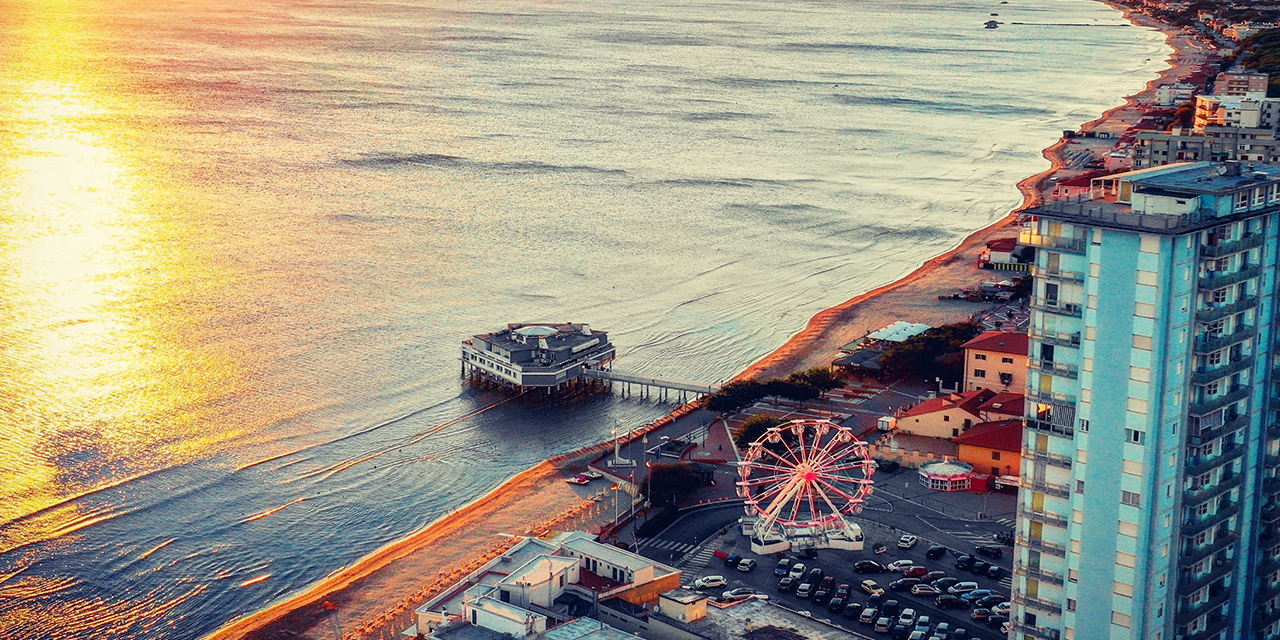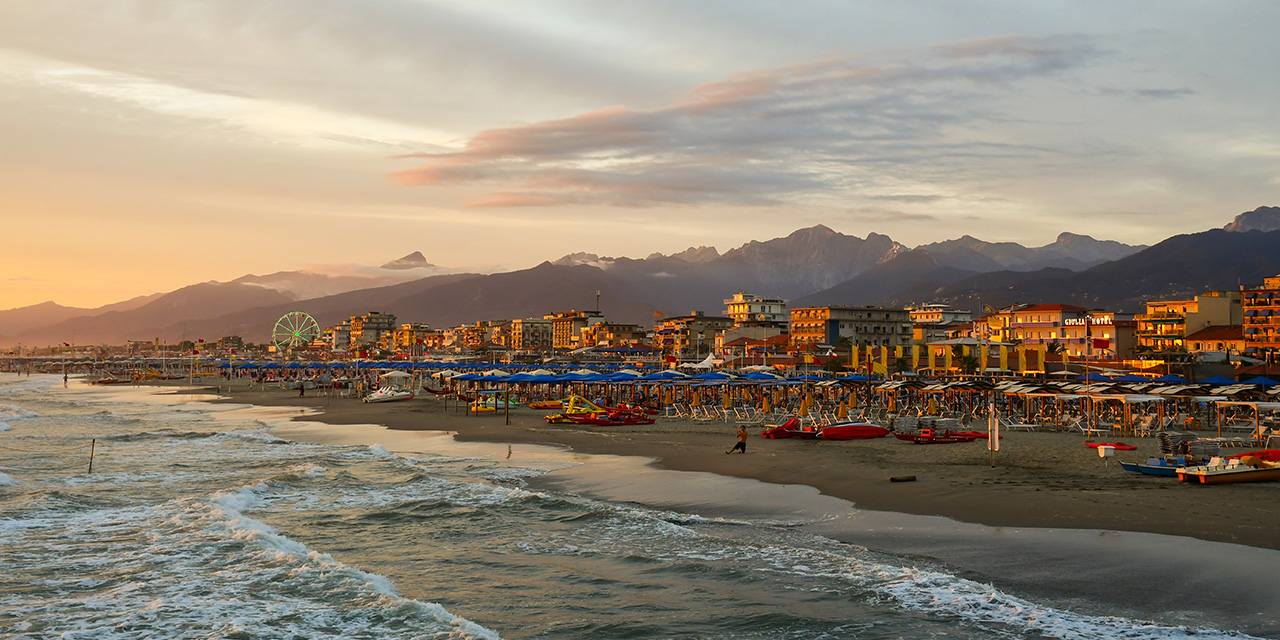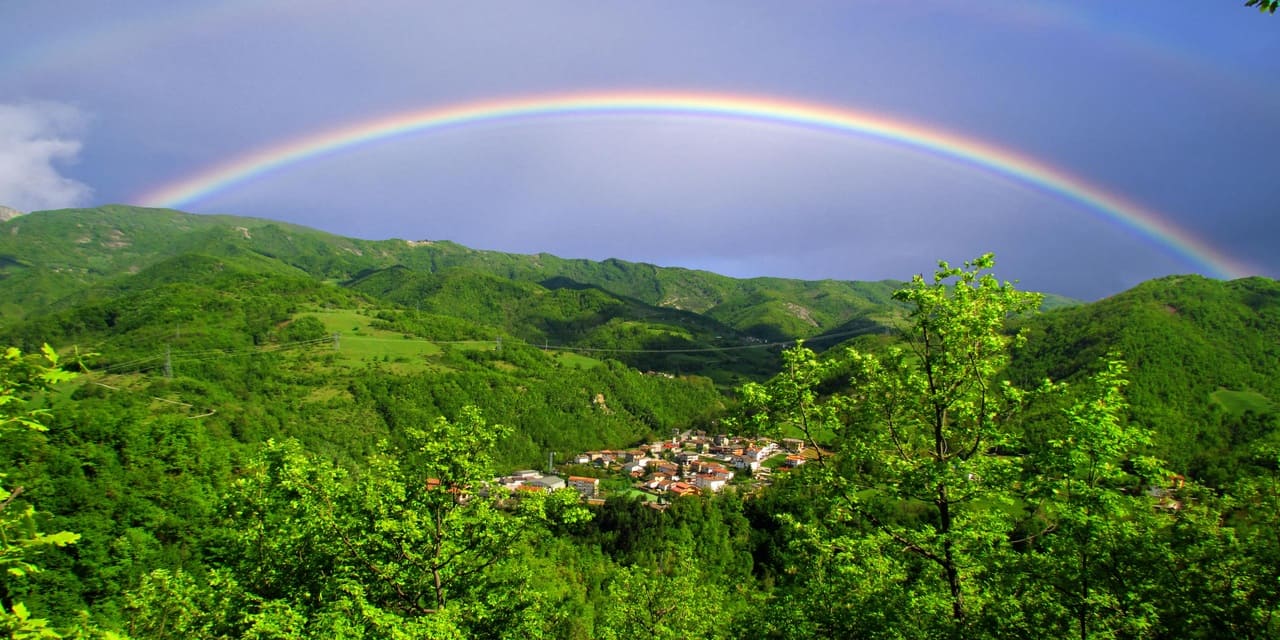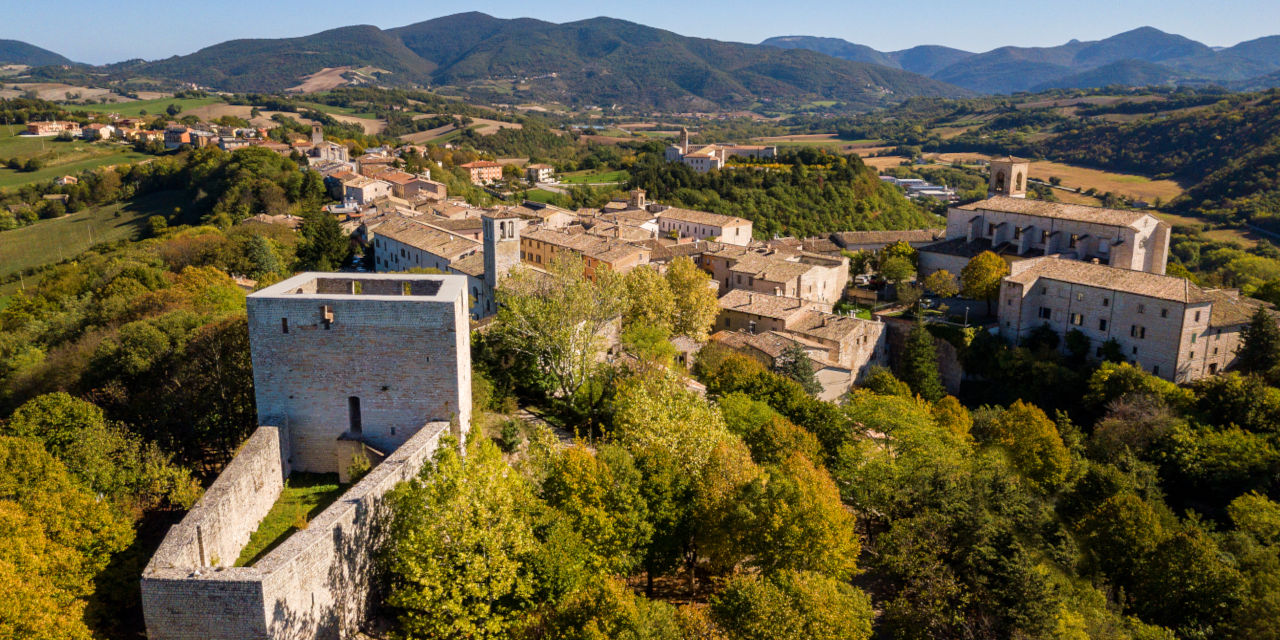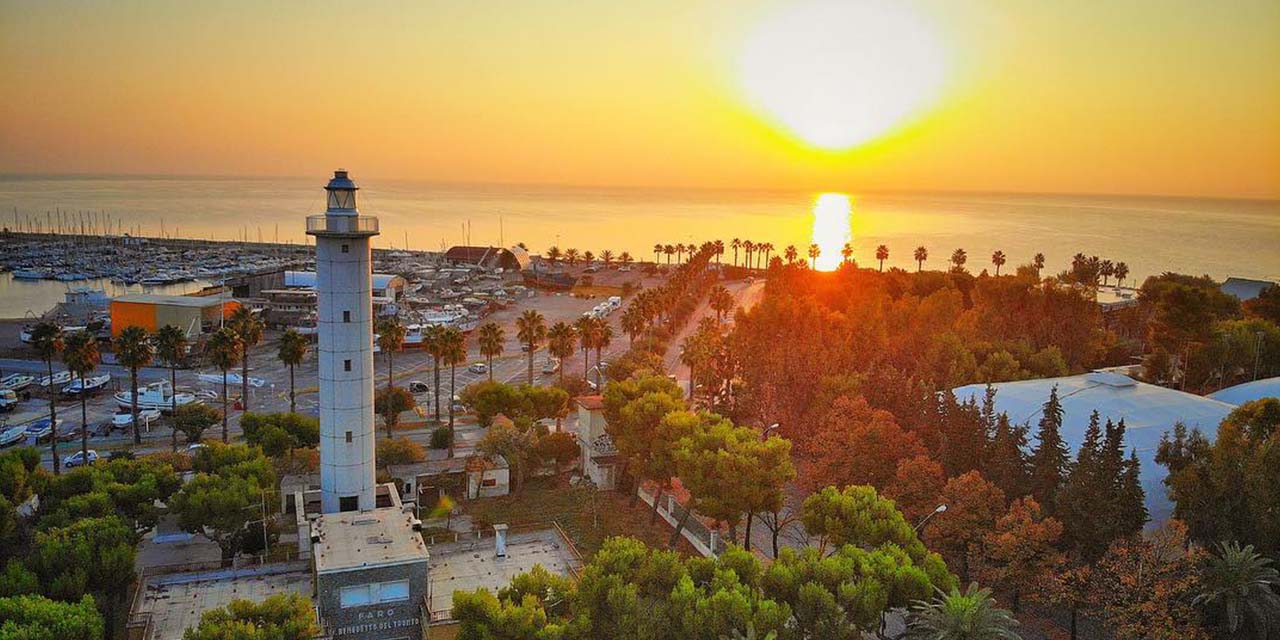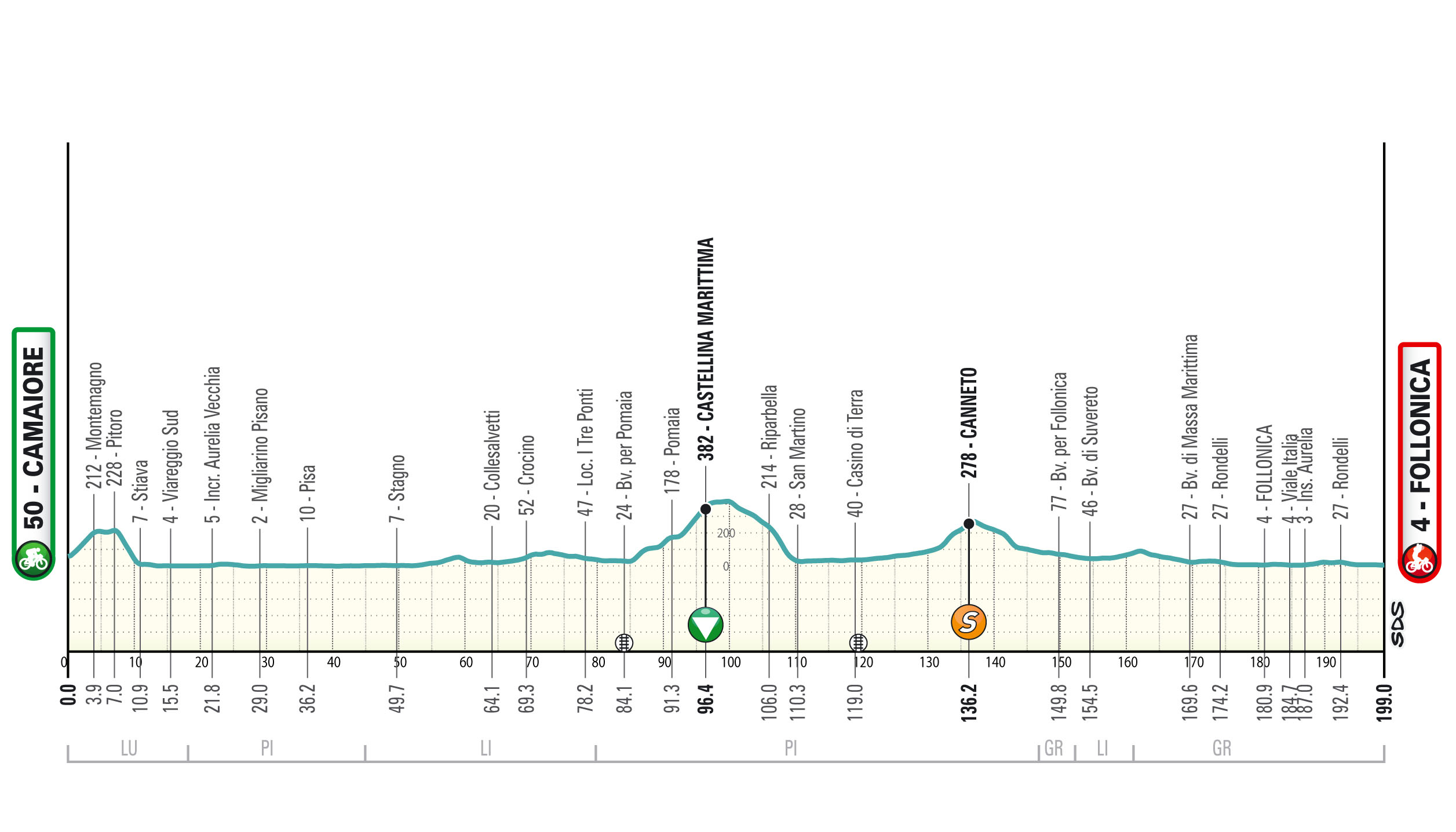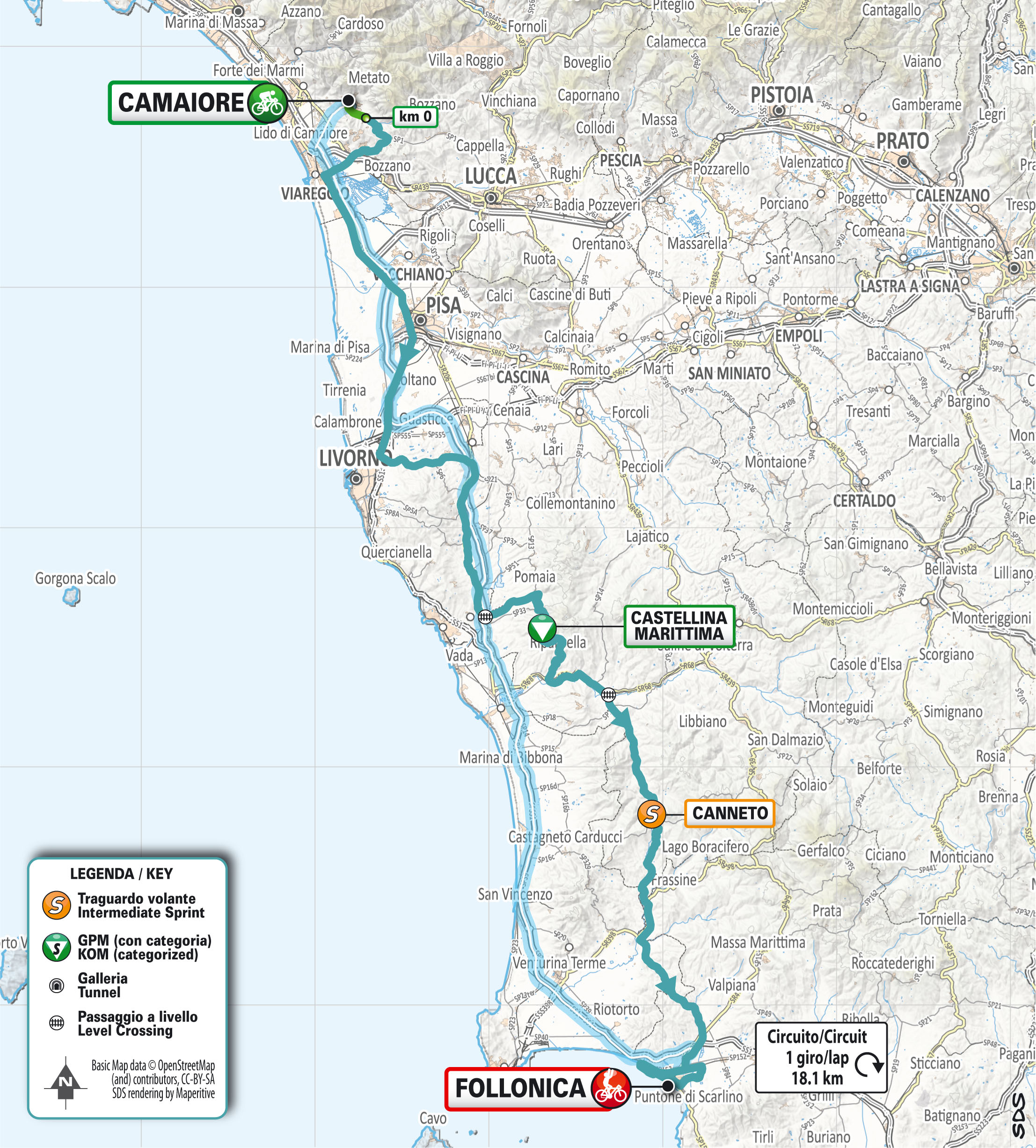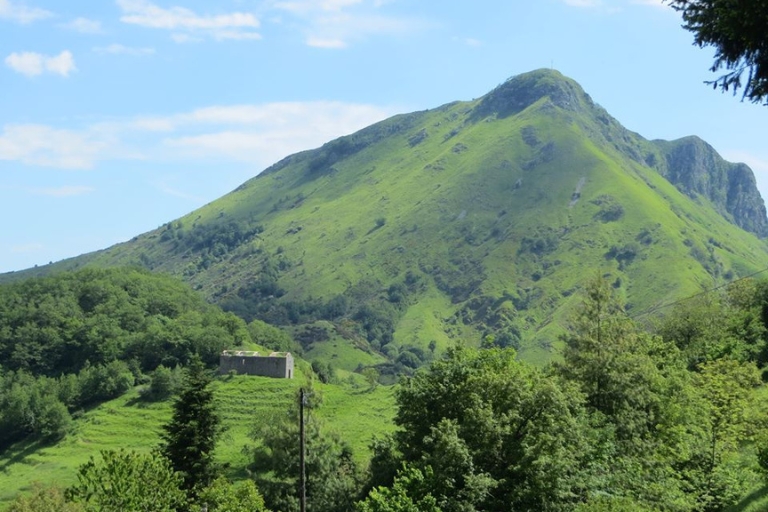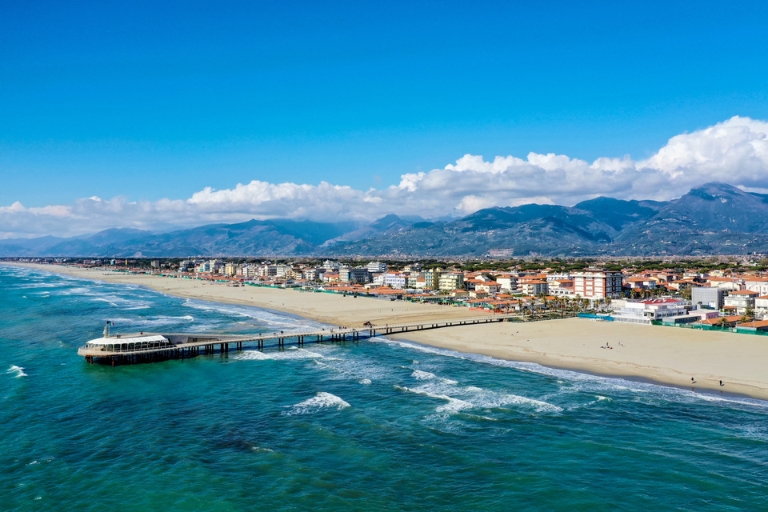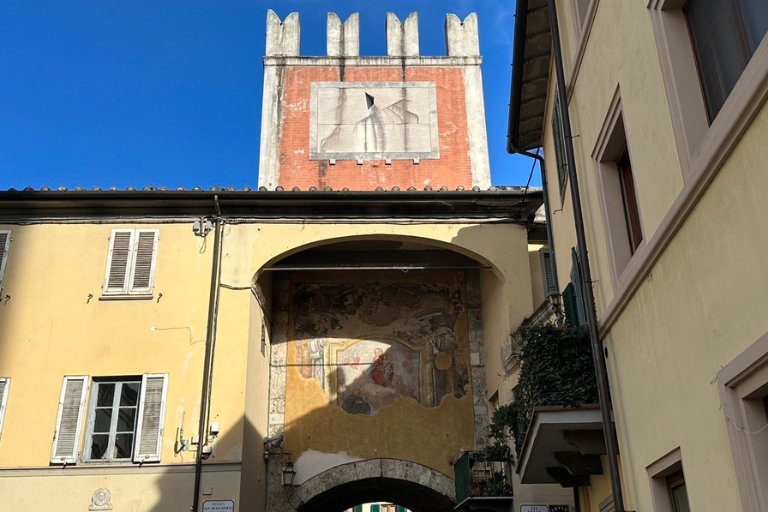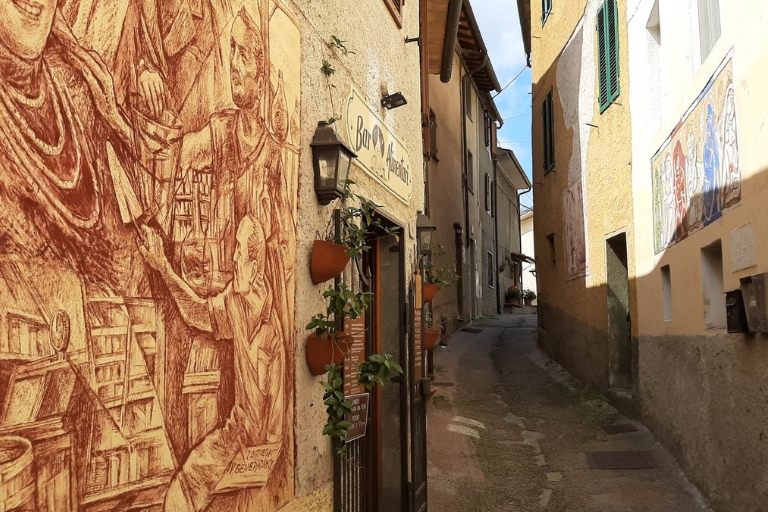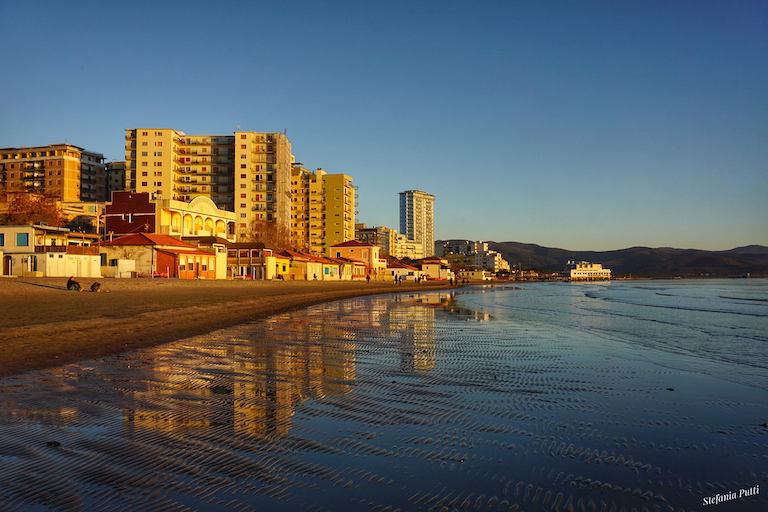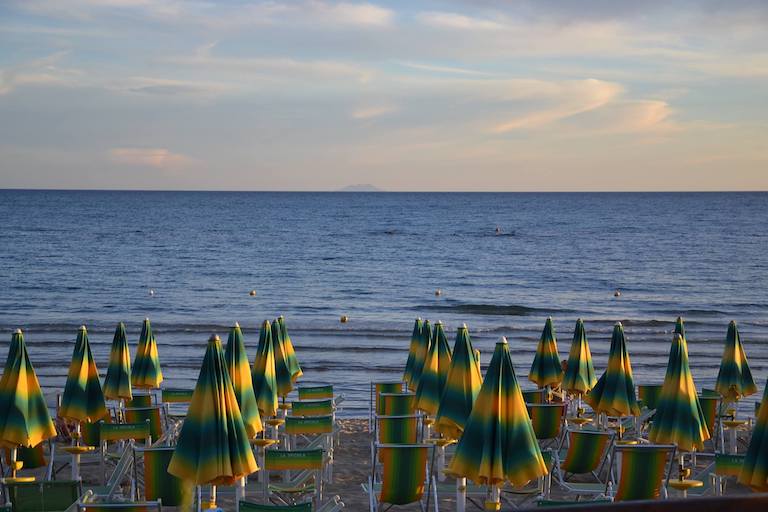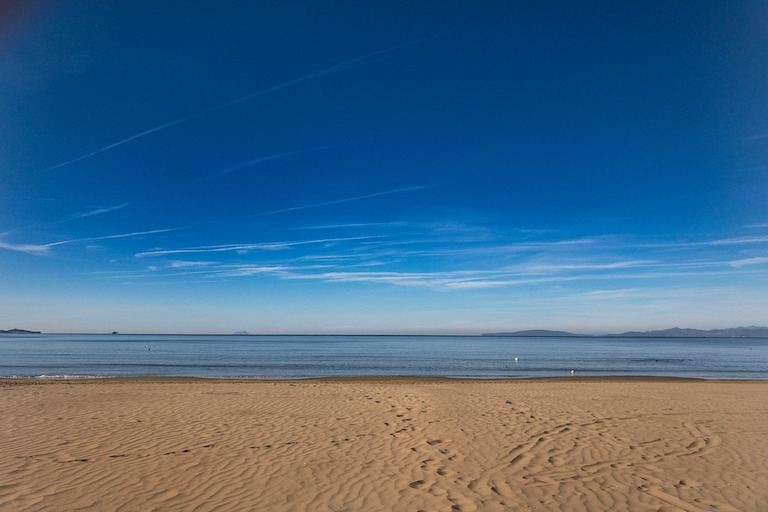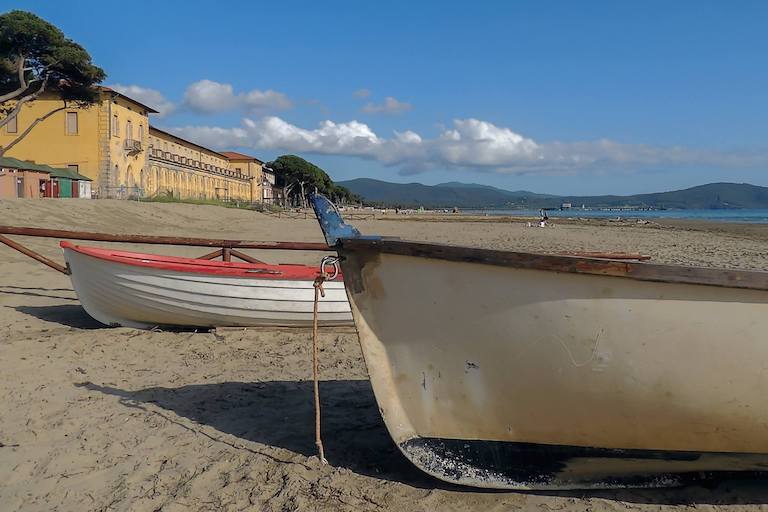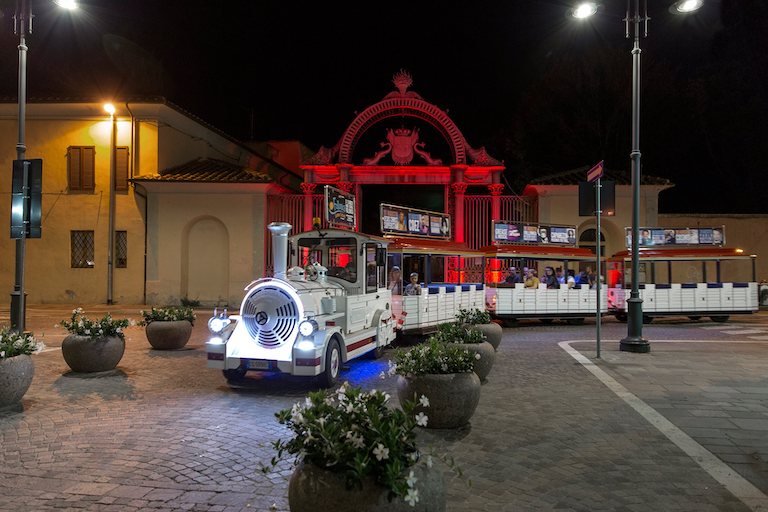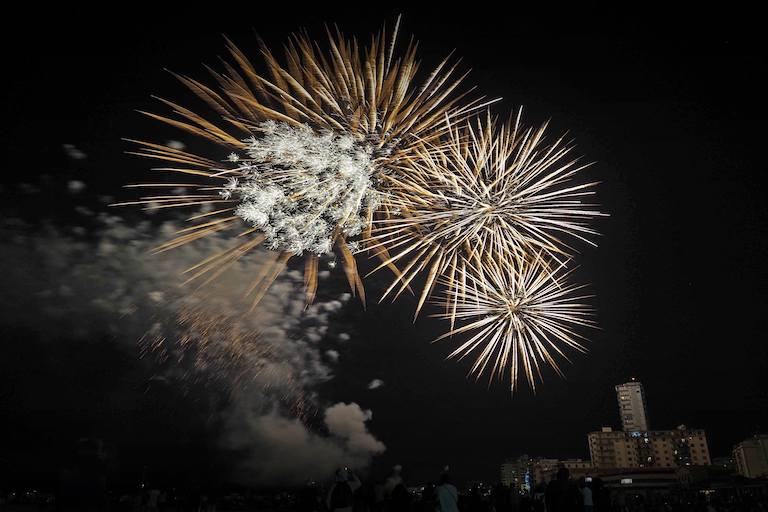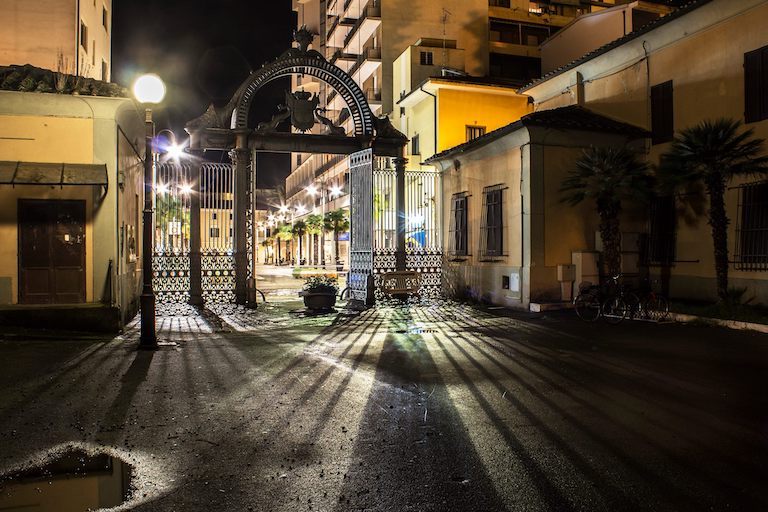learn more
technical info
profile
map
technical info
Varied and articulated stage, especially in the second part. Departing from Camaiore and crossing the town of Montemagno, the riders will first reach Pisa and then Livorno, before weaving goodbye to the flat ground and tackling the climb to Castellina Marittima. The race will then continue south through Riparbella and Canneto. At the end of a very long, mostly downhill stretch, the peloton will enter the final circuit of about 20 km to be repeated once.
Last km
The final circuit is almost entirely urban and features a few twists and turns. Last few kilometres mostly straight and well-paved, 8 m wide roadway.
start / finish
final kilometres
itinerary timetable
tourist info
Host city:
Camaiore
Overview
Camaiore is a nonpareil territory: nestled in the heart of Versilia, it’s one of the few Italian territories that can boast of splendid hillsides, framed by the majesty of the Apuan Alps, and of the horizon that gets lost and plunges into the Tyrrhenian Sea, drawing a breathtaking postcard.
The history of Camaiore has its roots in prehistoric times, as evidenced by the archaeological sites of Grotta all’Onda and Candalla. In medieval times, Camaiore had a crucial importance as a hub on the Via Francigena for the many pilgrims who found refreshment in the Badia S.S. Peter and Paul, still today a splendid example of Romanesque architecture. The city was surrounded by a wall – their remains can now be admired in the renovated Piazza XXIX Maggio, the beating heart of the city – and preserves, in the Historic Centre, the centuries-old symmetrical division into districts.
The twenty-three hillside villages crown the chief town, Camaiore. Then the territory develops towards the sea, meeting the city of Capezzano Pianore, specialized in the agricultural production of horticultural and flower crops. Finally, Lido di Camaiore represents one of the most important coasts of Versilia, where summer tourism reaches very high levels in terms of offer and quality.
Food
Camaiore is also a land of flavours, perhaps the most authentic and identifying of all Versilia’s cities: throughout the territory, food-and-wine reigns, offering experiential activities that represent part of its most important distinctive features.
A salty pie to try is undoubtedly the Scarpaccia. A particular name, almost funny, referring to the fact that, once cooked, the final product takes the appearance of an old shoe sole. Reference, however, not suitable for the taste: very tasty dish, it is based on courgettes and courgette flowers, whose scents are clear, not covered by a simple mixture of onion, water, flour, salt, pepper and oil. It’s perfect as an appetizer or as a picnic snack and it remains delicious even when cold, earning the label of Queen of Camaiore’s street food.
Also the historic Torta di Pepe, or “Torta co’ pizzi”, is absolutely characteristic: a pastry made with water, flour, eggs and salt is placed on a round baking tin and then filled with a mixture made with rice, chard, parsley, pecorino cheese, eggs, salt and pepper. It is necessary that the dough protrudes from the baking tin by (at least) two fingers, so as to be able to create the so-called “pizzi”: small “pyramids” of dough folded on itself that surround the entire cake. After having completed it with a sprinkling of pecorino cheese and having cooked it in a very hot oven for about 3-4 hours, it will be a true explosion of flavor in the mouth.
But the real characteristic dish of Camaiore are certainly the Tordelli. It is of course the most typical meal of Versilia, which was consumed by farmers’ families in peasant houses only on special occasions. That preparation is rooted in the territory, handed down from generation to generation, which over time has undergone various variations while maintaining unchanged the veracity of the taste. A minced of beef and pork, together with bread softened in broth, parmesan and pecorino chees, nutmeg, parsley and the inevitable “peporino” (i.e. thyme), create a filling of the traditional “tordelli” of fresh pasta. They must be seasoned with a good meat sauce and finished with a sprinkling of cheese directly on the plate. An unforgettable flavor. The true flavor of Camaiore served at the table.
Points of interest
Camaiore is a territory that has a vast tourist-cultural offer. The potential for a tourist is immense: in a few minutes by car, he can pass through the wonders of the hills, organized for footpath activities – included in the Francigena and Camaiore Antiqua routes -, trekking and climbing – currently a very popular practice, of which the Camaiore is one of the major Italian stages -, to arrive, passing from the green countryside, to the crystalline water of the sea, embellished by hundreds of bathing establishments, organized for each activity, and by the many clubs where you can spend the summer days.
The spearhead of the Lido coast is the “Bellavista Vittoria” jetty, which, with its 300-metre promenade on the sea, is a must for the citizens and the thousands of customers that come every year. Moving slightly to the north-east, there is the Bussoladomani Park, a historic area where, starting from 60s, stood the legendary Sergio Bernardini’s big tent, where internationally renowned artists sang and played throughout its decennial activity: it can boast of having welcomed Mina’s last public concert. After years of silence, now Bussoladomani has returned to play: presently it’s home of La Prima Estate, the flagship event of the musical season worldwide.
Heading inland, Camaiore is home of many events that promote local and territorial excellence. From “È la Via dell’Orto”, a two-day spring event in which are told local traditions related to the agri-food and food sector, to the centuries-old All Saints Fair (November 1 and 2), passing through the Pic Festival, an October fair to homage spicy flavors in collaboration with the National Academy of Peperoncino, and the fair-market dedicated to vintage and antiques things from the past, “Follie di Ferragosto”. From a historical point of view, events such as Corpus Domini take on a central role: a religious event which in Camaiore has taken on an absolute folkloric trait, thanks to the mastery of the “tappetari”, “carpet makers” who, every year, work in the night before the Solemnity creating real squares, all along the very central Via Vittorio Emanuele, with the sole use of colored wood sawdust. Of the same traditional importance is the appointment with the Processione di Gesù Morto, an event that every three years, on the Friday before the Easter, light up the Historic Center, during the evening, with thousands of oil lamps (the “cincindellori”) and helping to create a unique, magical, almost supernatural atmosphere.
Then going up towards the hilly areas, can be visited the hamlets of Monteggiori – a medieval citadel that preserves a fascinating thousand-year-old beauty -, and Casoli – a characteristic village that finds its own peculiarity, apart of the nearby Candalla waterfalls, in the wonderful Sgraffiti, ancient wall decoration technique deriving from the fresco on plaster, which embellish the town making it a unique pearl of its kind. It’s a stage of studies for hundreds of artists: the painter and sculptor Rosario Murabito fell in love with this village, until the decision to move there with his wife Grace Albert. But, in any case, each hamlet has unique characteristics that are worth experiencing and discovering.
Camaiore is a true land of colors and traditions, rich in history that lives on in the events and places and whose beauty transpires, with perpetual and bewitching strength, in every village and in every corner of every street.
Follonica
Overview
Follonica is one of the most popular summer destinations of the Grosseto Maremma and more generally of Tuscany.
The gradual urban expansion toward the sea, which took place mainly during the last century, has made Follonica a city with a strong tourist vocation, although its foundation dates back to the 16th century (AD), when it established itself in the Tuscan territory as an important steel hub.
The historic center of Follonica in fact coincides with the ancient perimeter wall (magonal fence) that enclosed the ironworks.
Points of interest
Follonica’s coastline is particularly prized for its sandy seabed that slopes slowly out to sea. A feature that allows anyone to be able to dive into the water without taking risks.
The numerous bathing establishments scattered along this stretch of the Maremma coastline offer sea lovers the opportunity to spend pleasant days on the beach in the company of friends and family. There is also no shortage of large stretches of free beach and DOG BEACH, dedicated to those who choose Follonica and the Maremma to spend their vacations with their dogs.
Follonica has been awarded the Blue Flag several times in the past 18 years. In 2017 it received the 5 Sails from Legambiente, ricons that have been a guarantee on the quality of the sea water and services provided to visitors since their establishment.
Follonica is a town rich in history, tradition and places to visit. The MAGMA – Museo delle Arti in Ghisa della Maremma (Museum of Cast Iron Arts of the Maremma), located in theformer iron and steel complex, offers the chance to get in touch with the history of Follonica and its territory. The Montioni Natural Park, on the other hand, offers the possibility of historical itineraries to discover some of the most important places for the territory during the Middle Ages.
- MAGMA – Museum of Cast Iron Arts in the Maremma, was inaugurated in 1970 in a temporary location. Since 1998, this museum of the Maremma has been permanently housed inside the old San Ferdinando Furnace. Inside MAGMA, thanks to the multimedia exhibit, it is possible to trace the process of cast iron production, both locally and internationally. In the Etruscan section of the museum, on the other hand, a number of artifacts found during the excavation of the Etruscan iron and steel settlement at Rondelli are on display.
- Follonica Theater: the former steel complex houses, in addition to MAGMA, the Follonica Theater. The restoration project of the Fonderia Leopolda, a building that currently houses the theater, was supervised by architect Vittorio Gregotti. Opened on October 27, 2014, with a concert by Franco Battiato, currently the auditorium can hold 400 people. There is also a cafeteria and a restaurant inside the theater.
- Art Gallery: the Pinacoteca di Follonica, dating back to the early twentieth century, was first Casa del Fascio, then Casa del Popolo and now houses the Civic Art Gallery. Inside are permanent collections donated by contemporary artists and painters, local and otherwise.
Videos Stage 02

Tirreno-Adriatico Crédit Agricole 2024 | Stage 2| Last KM 🇮🇹
5 Mar 2024
Tirreno-Adriatico Crédit Agricole 2024 | Stage 2 | Highlights 🇮🇹
5 Mar 2024
Tirreno-Adriatico Crédit Agricole 2024 | Stage 2 | Highlights 🇬🇧
5 Mar 2024Photos Stage 02

Tirreno-Adriatico Crédit Agricole 2024 | Tappa 2 | Best of
05/03/2024

